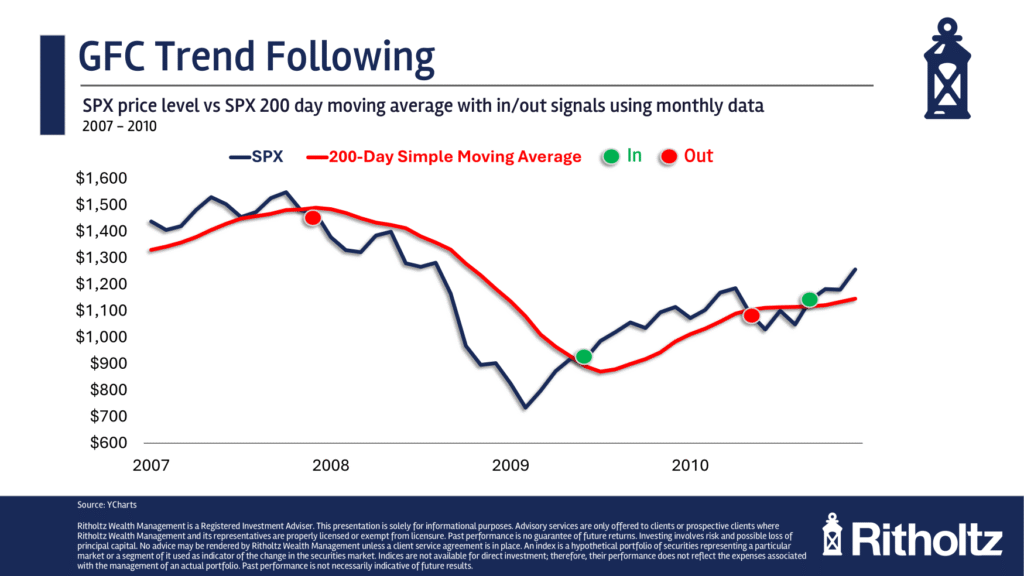A reader asks:
Could you talk about how to use momentum indicators and stop losses to profit from an AI bubble? Having been an investor during the 1990’s this feels like the early innings of a bubble, if this is one. I think there may be a relatively low risk way to profit without picking individual winners or time the top by using momentum indicators and using trailing stop loss orders on broadly-based, passively managed ETFs.
In the spring of 2006, Meb Faber published a research paper titled A Quantitative Approach to Tactical Asset Allocation.
The idea was to use a 10-month moving average to dictate your allocation between risk assets (stocks) and cash (T-bills).
The rules were simple. At month end:
- If the current price is greater than the 10-month moving average, stay invested in stocks.
- If the current price is less than the 10-month moving average, invest in cash.
If you’re in an uptrend, you buy or stay invested. If you’re in a downtrend, you sell or stay in cash.
The idea behind the strategy is to dampen the volatility and the risk of severe market drawdowns in risk assets.
The timing of the paper couldn’t have been better. A little more than a year later, the stock market peaked at the onset of the Great Financial Crisis. The S&P 500 fell nearly 60%.
So how did Faber’s rules work? Incredibly well.
Meb updated his paper a few years later to show how the backtest performed in the real world:
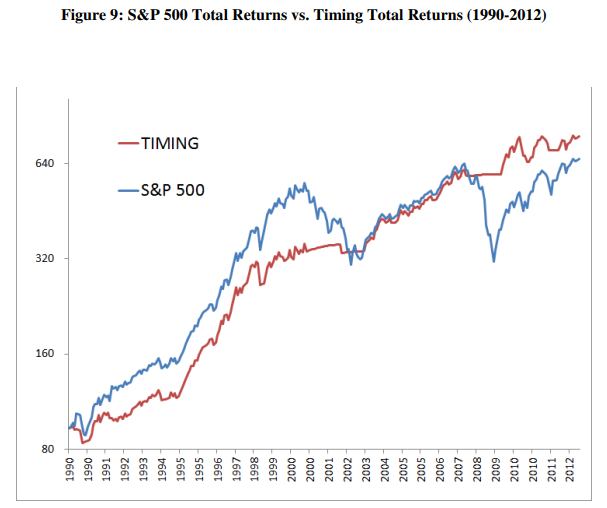
The strategy didn’t get out at the exact top because you need to wait for a downtrend to take hold before getting a signal but it missed the majority of the carnage.1
These were the long-term return profiles for trend following versus buy and hold:
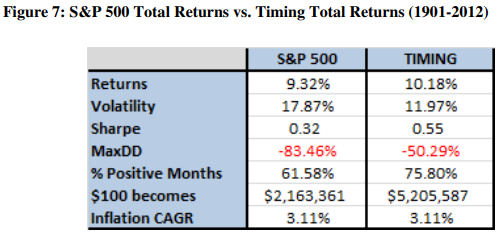
Trend following didn’t completely take drawdowns off the table, but it did dampen volatility significantly in these 110+ years of data.
Now look at the performance of the worst years in the stock market versus the trend strategy:
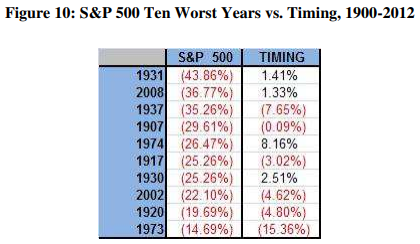
This type of strategy is designed to shine in the worst stock market environments.
There’s nothing magical about 10 months or a monthly indicator on these things but the point is you want to have a time frame that allows you to better define uptrends and downtrends.
Bad things happen more often in downtrending markets because investors tend to panic more freely when they’re losing money. This is why both the best and the worst days occur during bear markets.
Downtrends pave the way for a broader set of possible outcomes, and not always in a good way.
Here’s a look at using a simple 200-day moving average on a month-end basis during the 2008 financial crisis:

The sell signal was triggered 6% or so below the peak which was very good timing. Then you got back in roughly 20% off the lows. That’s pretty good considering the size and length of the 2007-2009 crash.
Now here are the signals during the dot-com bubble:
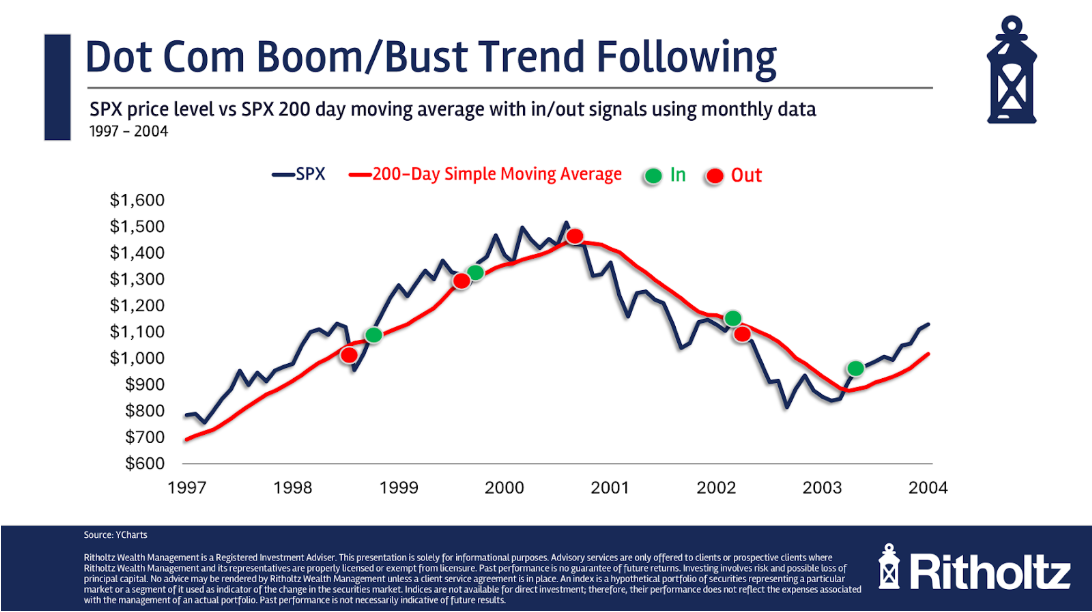
You can see there were some false positives along the way to the peak of the dot-com bubble. You sold and got right back in during the 1998 volatility. There was a whipsaw again in 1999 when the moving average triggered a sell signal followed shortly by a buy signal.
But then there was a month-end sell signal just 6% below the 2000 peak that kept you out of the majority of the 50% crash. One more quick whipsaw in 2002 but again a trend following system helped you survive a severe downturn.
So why would you ever invest in anything else?
Well, trend following is a wonderful hedge against severe market downturns. But severe market downturns don’t happen that often. Crashes are rare.
Drawdowns don’t always happen in waterfall fashion. If there is a flash crash situation a trend following strategy won’t save you. And in choppy markets you can get whipsawed.
Look at the 2022 bear market:

You bought high, sold low, bought higher and then sold low again. You still missed a decent amount of the drawdown but those whipsaws can test your patience.
You could see a down 10% month, sell and see that followed by an up 10% month where you buy after the gain. Now, you’ve just eaten all of the losses and missed out on all the gains in a short window of time.
Here’s the thing about a trend strategy — you have to follow the rules for it to work. No wavering. No emotions involved. You can’t buy and sell when you feel like it because no one knows whether a 15% correction will turn into a 50% decline or not. Most of the time 20% down doesn’t turn into 40% down but no one knows that in the moment.
Trend following is an insurance strategy where sometimes you’re forced to pay the premium without the protection. Most of the time when you trigger a sell the stock market won’t completely fall out of bed but you don’t buy insurance on your house hoping it burns down.
Sometimes the stock market does burn down, but those are rare occurrences.
You also have to consider taxes. When you trigger a sell signal you could be forced to pay short-term capital gains. Or after a long bull market you could be forced to pay long-term capital gains. That eats into your returns. Trend following works much better in a tax-deferred account than a taxable brokerage.
Bull markets are another positive for this strategy.
Most hedging strategies provide downside volatility protection with no upside. The beauty of trend following is that it stays invested as long as the stock market remains in an uptrend. And when the uptrend breaks, there is an off-ramp.
This type of strategy isn’t for everyone. I’ve had plenty of conversations with people over the years who simply don’t want or need a volatility/behavioral release valve.
Others desire something that will allow them to stick with the rest of their long-term plan. That’s why I think trend following is a nice complement to a longer-term buy-hold-and-rebalance asset allocation.
These strategies can act differently in different environments and at different points in the cycle.
The potential for reduced volatility is nice, but it’s the diversification benefits that helped me understand the point of trend following in a portfolio.
I don’t know if trend following will protect you when the next big downturn hits.
But this is the kind of strategy where you need to understand the trade-offs before investing.
If you want to learn more about how we do this for clients, reach out here.
I did a deep dive into this question on this week’s Ask the Compound:
Bill Sweet joined me as well to discuss questions about Roth IRAs before retirement, buying your dream home, capital loss carryforwards, 529 plans and buying a vacation home for estate planning reasons.
Further Reading:
My Evolution on Asset Allocation
1It’s also worth noting that the trend strategy underperformed in the 1990s bull market by a decently wide margin. You should expect that with a strategy like this.
(Source)

